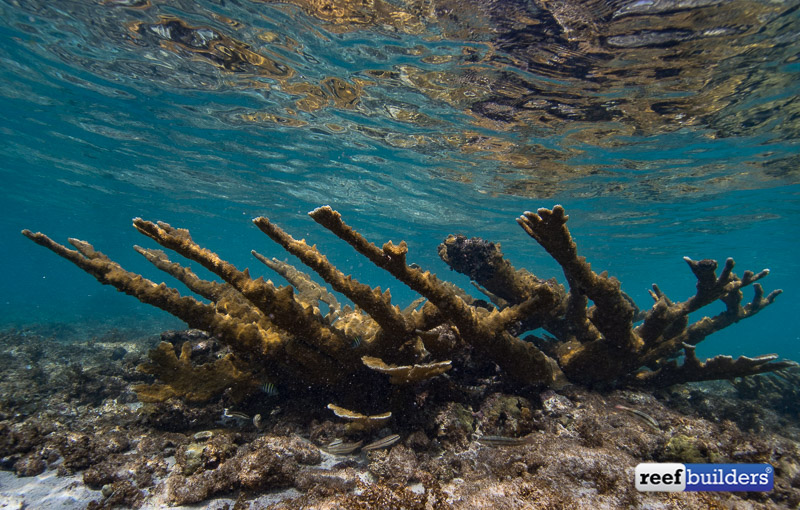Acropora palmata, the Elkhorn Coral, is the quintessential Caribbean Coral Reef species. This species was once so abundant that entire regions of the reef were called the ‘Palmata Zone’ and it was important to know where the palmata zones were, because their sturdy branches easily sank ships.
Unfortunately, the risk of shipgrounding on big ‘trees’ of Acropora palmata is a long forgotten memory. This species, once the iconic coral for the Caribbean, is now the poster-child for coral reef decline. With a natural abundance reduced to one percent of its former glory, Elkhorn coral is truly deserving of all federal and international protections of an endangered species.

Despite its rapid and dramatic decline in the 20th century, there are still some places in the Caribbean where Elkhorn coral is holding on, and still dominating certain regions of the reef. We spent quite a bit of time working on such a Palmata Reef at Rincon, Puerto Rico nearly ten years ago, but it’s been so long since we’ve seen a good stand of this quasi-mythical coral.
The thing is, you can still find Acropora palmata growing everywhere, but it’s usually just a small remnant, a large encrustation or one poorly developed branch just trying to hang on to life. Thankfully, on our recent visit to the Dominican Republic, we had a nice refresher on why this coral is so special when it is covering a nice spread of wave-washed shallow reef.

For our diving tour of Dominican Republic, we were really looking forward to exploring some middle depth reefs where we knew that the Caribbean’s most unique corals could be found. Montastrea cavernosa, Meandrina, Agaricia and Mycetophyllia are all species of corals from the tropical west atlantic which have no real counterparts in the Indian and Pacific Oceans so these are the coral targets we really looked forward to seeing and photographing.
Thankfully, seeing and documenting the Caribbean’s lesser known corals was a complete success, and several dives at some key sites brought us face to face with a veritable catalog of rare living corals. With our primary coral photo targets acquired, we shifted our focus to shallow reef waters and set out to see what Acroporids we could find around Punta Cana.

We connected with the Puntacana Foundation to visit their coral nurseries where they’ve had immense success growing and propagating huge quantities of Caribbean staghorn coral, Acropora cervicornis. Seeing huge thickets of completely healthy staghorn coral was such a refreshing sight, and we are truly impressed with how well the Puntacana Foundation has been able to create and outplant countless frags on nearby and neighboring reefs.
However in the back of our heads we couldn’t stop thinking about the spirit animal of Caribbean reefs, the elkhorn coral. We got some intel that there was ‘some colonies’ growing not far from the staghorn coral nurseries, but the extent of this Palmata stronghold was not thoroughly conveyed to us. We expected to see a few colonies in the surf zone, holding on and growing in some limited capacity.

Thankfully, we were pleasantly surprised to see that a true palmata zone still existed in Punta Cana, with healthy Elkhorn coral colonies dominating the surf zone for at least a hundred feet. There was just enough Acropora palmata growing in this one area that for a moment, while swimming in the center of it all we could see was Elkhorn coral in every direction.
For a brief moment in time it as possible to take the sight of Acropora palmata, multiply it by an order of magnitude, and imagine what the historic palmata zone might have been like before this coral was nearly wiped out. If seeing fields of staghorn was refreshing, then seeing a strong healthy stand of Acropora palmata was closer to a religious experience, and we can’t wait until the next time we come across a small forest of Elkhorn coral.



